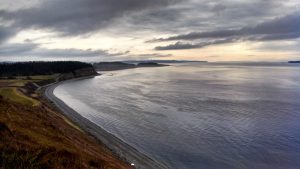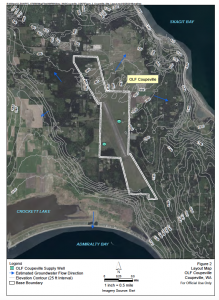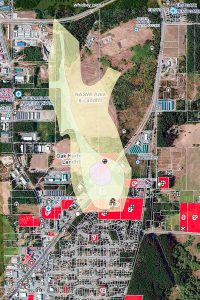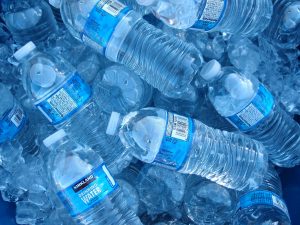
Josh Miller
Water is the foundation of all living things. Whether it is used for drinking, gardening, or washing, water is the bedrock upon which all life rests. Wherever clean water is threatened, so too is life threatened. In few places is this as pertinent as it is for the communities of Whidbey Island, surrounded as they are by saltwater, and provided by a single-source aquifer which receives no replenishment in the summer (Citizens of Ebey’s Reserve 2016b). Saltwater intrusion provides an additional challenge to an already complicated water supply. These combined factors mean that water access is typically lowest when water demand is at its highest. In all, an approximate 80,000 citizens rely on water provided through this aquifer, including schools and hospitals, many through privately owned wells (United States Census Bureau 2010).
In addition to these preexisting complications to their water supply, Whidbey Island residents are now also contending with severe water contamination from the towns largest industry – the United States Navy. More specifically, their water supply is being contaminated by Naval Air Station Whidbey Island (NASWI), whose training practices have placed the local water supply, and by extension the local residents, directly in harm’s way.
Contaminants
What are these contaminants, and what threat do they pose to the residents of Whidbey Island? According to one study of contamination related to NASWI, “Contaminants of concern include heavy metals and organic solvents disposed in landfills; PAHs, and waste oils burned during firefighting training; jet fuels an other POL spilled on the flight line and hangar areas; and pesticides” (Naval Ocean Systems 1998). The primary contaminants of concern in relation to the water, however, are a family of per- and poly-flourinated alkyl substances referred to collectively as PFASs (Grossmann n.d.). These “forever chemicals” are found in the fire-fighting foams used by the Navy on its airfields and fleet ships (Bernton 2017).
More specific to Whidbey Island, the foams are used for training exercises at NASWI’s Ault Field in Oak Harbor, and at the Out-Lying Field (OLF) in Coupeville, where pilots practice touch-and-go landings in the middle of one of Whidbey Island’s most densely populated areas. In an interview with Truthout, Rick Abraham – a public interest advocate working on toxic pollution issues – said that PFASs “… were found in the aquifer beneath the OLF airstrip in October 2016, and are known to have migrated off-site to contaminate public and private drinking water” (Jamail 2017). Some wells in Coupeville contain PFAS foams in quantities 400 percent higher than the accepted level established by the Environmental Protection Agency (EPA) (Ibid.).
While the recommended concentration of these chemicals is at or below 70 parts per trillion (ppt), research suggests that even concentrations below this recommended amount may still have negative health impacts. (Citizens of Ebey’s Reserve 2016b). A number of local and state governments have set significantly lower caps on these chemicals, citing health concerns as the primary reason. (Ibid.) In June 2018, the federal Agency for Toxic Substances and Disease Registry (ATSDR) released new toxicological profiles which lowered the level of harmful exposure to seven to ten times lower than the EPA’s recommended concentration (Abraham 2019).
According to Environmental Working Group data in June 2022, four areas near U.S. military bases “exceeded 100 ppt for PFOS [a type of PFAS], with three of these exceeding 800 ppt, and one – the Naval Air Station Whidbey Island – registering a staggering level of 4,720 ppt. Experts argue that this widespread, massive contamination is caused by military’s use of aqueous film-forming foam (AFFF), which contains high levels of PFAS, in training exercises and emergencies” (Ionescu 2022).
Health Impacts
Health impacts from certain PFAS foams include decreased fertility, increased cholesterol, hormone imbalance, increased cancer risk, and immune system damage (Citizens of Ebey’s Reserve 2016b). Additionally for developing fetuses and children, exposure can reduce immune response to certain vaccinations, increase the risk of infection, and change growth and learning behaviors (Ibid.). These effects are made worse by the fact that PFASs bio-accumulate, meaning they do not break down in the body easily and, as a result, build up in the bloodstream. It takes eight to nine years for some PFASs to decrease by half once in the blood. (Jamail 2017). As a result, more PFAS can be in the blood of an individual who drank contaminated water, than in the water itself (Ibid.).
Outside the health impacts, property values have dropped sharply since the discovery of PFAS contamination, and many homeowners have become trapped as a result – being unable to even sell their homes and move away (Jamail 2017). This is doubly damaging to owners of agricultural lands, whose livelihoods depend on access to large quantities of clean water.
Culprits behind the chemicals
How did the chemicals get into the groundwater? The short answer is through OLF Coupeville and Ault Field. In all, of the 230 wells tested by the Navy on Whidbey Island, 13 have been found to contain concentrations of PFAS above the EPA health advisory limit – this of course ignores those wells which the Navy has not yet tested, and those wells which contain concentrations which are still damaging to one’s health (Wilkinson 2018).
Out-Lying Field (OLF) Coupeville
OLF Coupeville – being at the center of one of Whidbey Islands most densely populated areas, is in perhaps the worst place it could be for the safety and well-being of local citizens. Not only does its placement endanger the surrounding homes and businesses with the possibility of a crash, but it also puts the nearby unprotected well at heightened risk of contamination.

Furthermore, the airfield is located directly above the main aquifer recharge area for that part of the island. In addition to hundreds of businesses and homes, the well – and by extension the aquifer – provides water to local schools and Whidbey General Hospital, the most vulnerable populations who have the most to lose from drinking contaminated water (Abraham 2019). Whether it comes from a crash and the extinguishing of the resulting fire, or from the leakage of existing fire-fighting chemicals, the OLF’s placement represents a significantly heightened risk factor to the surrounding community which is massively disproportionate to the security benefit it provides.
Ault Field

While OLF Coupeville is often the central focus of concerns about PFAS contamination on Whidbey island – primarily due to its precarious placement – Ault Field is likewise a significant source of pollution in the region. At least one home in Oak Harbor near Ault Field has recorded contamination at levels 35 times higher than the EPA’s suggested threshold. While Navy testing efforts have yet to reveal a full picture of PFAS contamination in the area, at least three wells have been known to be contaminated above EPA standards near Oak Harbor alone (Bernton 2017). Furthermore, new PFAS contamination has been found in Ault Field’s surface water which flows directly into Puget Sound (Abraham 2019). In addition to PFAS, a plume of 1-4-Dioxane has been found which originates from Ault Field’s Area 6 landfill, previously an industrial and household disposal site. (Stensland 2017) 1-4, Dioxane is a known carcinogen, and its plume reaches all the way into Oak Harbor city limits (Ibid.). According to Judy Smith of the EPA: “The Navy was originally scheduled to have completed a proposed plan for dealing with the 1,4-Dioxane contamination . . . but the project was pushed back because testing for [PFASs] in civilian drinking water wells on North and Central Whidbey took priority” (Ibid.).
Ault Field was declared a Superfund site – an area designated by the federal government as needing long-term cleanup – in 1992, with nine distinct areas of contamination. From 1969-88, the 260-acre Area 6 landfill site was used to dump multiple forms of chemical waste. Among these waste-products were 2.2 million gallons of liquids and sludge, 300,000-700,00 gallons of acids and solvents, 100,000-600,00 gallons of oil sludge, and an unknown quantity of various other forms of waste such as oils and asbestos (Ibid.).
In farmland downstream from Ault Field, Clover Valley Creek “frequently floods, depositing sediments and possibly chemical contaminants on some of the farm’s low-lying acreage used for grazing and crops. And downstream, the pollution makes its way into Puget Sound’s Dugualla Bay, a rearing area for young chinook salmon” (Bernton 2019b).
Navy Response
Under the National Historic Preservation Act, the Navy is required to consult with state and local groups regarding the effects of its Growler program’s expansion. It is not, however, required to come to an agreement. When the Federal Advisory Council recommended additional monitoring of the Growler training program – including impacts to noise levels, local investment, and the town’s tourism industry – the Navy simply refused outright. In early December 2018 the Navy ceased communication with state and local groups on the issue altogether, citing a “fundamental difference of opinion” as their reason (Bernton 2019a).
Worse-yet, the Navy plans to significantly increase the EA18 Growler jet training program, a move which would result in significantly greater potential for PFAS contamination (Jamail 2017). If the Navy has its way, landings and takeoffs would increase fourfold, and up to 36 aircraft would be added to NASWI’s current fleet of 82 (Bernton 2019).
This problem is underscored by the fact that both the Navy and the foam manufacturers knew about the negative health impacts of PFAS chemicals since at least 2001 (Citizens of Ebey’s Reserve 2016b). One particular provider of firefighting foam, 3M, even announced it would cease production altogether precisely because of concerns about the toxic potential of its contents (Ibid.).
When the Navy was finally forced to test wells around the OLF for traces of contamination, what it found was nothing short of outrageous. Within one mile of the OLF’s first known contamination site, PFASs were found in quantities as high as 600 ppt (Ibid.). In March 2017, the Navy tested 27 more wells, and found concentrations of some PFASs as high as 1,190 ppt (Abraham 2019).

Many families who live near these contaminated wells have been forced to abandon them in favor of bottled water which is now distributed by the Navy (Cauvel 2018). The many organic farms which sprawl across hundreds of acres on Whidbey Island depend on their access to large quantities of water, and only having access to it by the bottle is simply not acceptable to the farmers (Abraham 2019), Furthermore, many veterans remember their time deployed overseas washing and brushing their teeth from bottles of water due to lack of sanitation. Now the same expectation is levied on
them in their own homes, in the country they put their lives on the line to protect. Is this the way Uncle Sam repays service in the armed forces? After two years of waiting for a solution that seems like it will never come, many on Whidbey Island still depend on water bottles distributed by the very polluter who has thus far refused to adequately address the issue it has created.
Obfuscation
Many Whidbey Island any residents feel that the Navy misleads or misinforms the public, not unlike a number of industrial polluters, to mitigate its own liability and minimize negative publicity associated with its actions. Where it cannot rely on misinformation, it relies on softball compromises to halfway fix a problem which deserves a conclusive solution. The symptoms of its mistakes are addressed only insofar as the law directly stipulates, leaving many necessary fixes untouched.
In 2016, when the Navy first discovered PFAS contamination of the aquifer under its base, it began sampling nearby public and private drinking water wells for contamination. The sampling, however, was conducted in such a way that obscured the truth rather than reveal it. First, the Navy only tested for three of the six PFAS contaminants it knew to be in the water based on tests it had conducted on its own property (Abraham 2019). Higher detection limits were used when sampling the community’s water than were used on the Navy’s property, so that lower concentrations would not be detected, possibly so that some PFASs could go undetected all together (Ibid.). Furthermore, the Navy requested that the Island County Health Department keep their plan to test the community’s water confidential until the testing was already being conducted (Ibid.). These methods allowed the Navy to avoid acknowledging the breadth and severity of contamination on Whidbey Island, and the role of NASWI as the center of that contamination’s spread.
In October 2017, the Navy retested some of the drinking water wells,” … to ensure residents living near our installations are not being exposed to PFAS in off-base drinking water” (Abraham 2019). This retesting of the wells was seemingly intended to hide rather than reveal the truth about NASWI related contamination. Eligibility for testing was only offered to those whose wells had previously recorded PFOA or PFOS contamination – two types of PFAS out of seven known to be in the water supply. Those with properties adjacent to another property that recorded PFOA or PFOS concentrations above the EPA standard were also eligible for testing, but not anyone who had recorded amounts below that threshold, or recorded amounts of other PFASs (Abraham 2019). This limited access reduced the number of contaminated wells which would be retested, and by extension the number of people who would be eligible for the intentionally vague “long term solution” the Navy was promising. It also minimized the image of a spreading wave of contamination that might have reached wells where contamination was not previously detected.
Furthermore, the EPA, under existing environmental law, is unable to eliminate the PFAS contamination on Whidbey Island by itself. Under the Toxic Substances Control Act, established in 1976 to “regulate the introduction of new or existing chemicals,” no provision yet exists by which the PFAS-containing firefighting foams could be banned outright (Citizens of Ebey’s Reserve 2016b). Even after the EPA negotiated an agreement with the various chemical-producing companies to change the chemical composition of their firefighting foams to remove some PFASs, the Navy just continued to use older versions of the foam which still contained them (Ibid.).
If the Navy were to lose access to its PFAS ridden fire-fighting foam, “there will certainly be a major impact to Carriers as well as the rest of the Navy,” said Jeff Fink, deputy systems engineer manager for a 2001 military workshop on the future of foams in Navy carriers and installations (Citizens of Ebey’s Reserve, 2016b). Restocking all of the Navy’s fleet and training installations with PFAS-free foams might be a time-consuming endeavor, and one that would leave the Navy potentially vulnerable for a short time – but it’s certainly not an option outside of the Navy’s reach, and poses a far less significant threat to the safety of U.S. citizens than does the contamination of their drinking water.
Conclusion
While some local residents have taken to filing lawsuits against the foam manufacturers, a list of actions has been suggested by the citizens of Ebey’s Reserve to help start addressing the issue. First and foremost is the installation of filtration systems on at-risk and contaminated wells, both public and private. This is the most straightforward action that could be taken for the sake of Island County resident’s health. Providing a source of clean water to those who are currently dependent on bottled water would be a strong first step in rectifying the issue.
Additionally, retesting and monitoring all at-risk or contaminated wells for all seven PFASs detected at the OLF should be an equally high priority. Without an accurate depiction of the various chemicals being leaked into the aquifer, as well as their quantities at different locations, any fix applied to the issue will likely be misplaced, or temporary. The results should also be made public, so that the communities can be more transparently informed about the level of contamination in their water supply.
Sources
Abraham, Rick. (2019, January). The Navy’s PFAS Contamination of Whidbey Island’s Aquifer and Drinking Water. Richard Abraham Consulting.
Bernton, Hal. (2017, March 3). Whidbey Island Drinking-water Wells Polluted with Fire Fighting Chemicals Near Navy Airstrips. Seattle Times.
Bernton, Hal. (2019a, March 11). Navy rejects call for more monitoring of growler jet training on Whidbey Island. Seattle Times.
Bernton, Hal. (2019b, December 10). New trouble on Whidbey Island as chemicals from Naval Air Station contaminate a creek. Seattle Times.
Cauvel, Kimberly. (2018, June 24). Navy Continues Search for Water Contamination. The Spokesman Review.
Cauvel, Kimberly. (2019, February 9). Whidbey Island Resident files Lawsuit Over Water Contamination. Go Skagit.
Citizens of Ebey’s Reserve. (2016a, December 15). Navy Contaminated Coupeville Water. Citizens of Ebey’s Reserve.
Citizens of Ebey’s Reserve. (2016b, December 15). Water Contamination. Citizens of Ebey’s Reserve.
Citizens of Ebey’s Reserve. (2016c, December 15). Other Issues. Citizens of Ebey’s Reserve.
Citizens of Ebey’s Reserve. (2017, October 25). Navy Updated on Contaminated Water. Citizens of Ebey’s Reserve.
Grossmann, Kayla. (n.d.). PFOS and PFOA: What You Need To Know About These Common Chemicals. The Radiant Life.
Ionescu, Andrei. (2022, June 27). “Forever chemicals” found in drinking water near U.S. military bases. Earth.com.
Jamail, Dahr. (2017, July 12). Navy Introduces Toxins to Drinking Water Then Expands Operations. Truthout.
Jamail, Dahr. (2018, March 26). What Happens to a One Industry Town When the One Industry is the Military. Truthout.
Naval Ocean Systems Center San Diego CA. (1998, August). Navy Aquatic Hazardous Waste Sites: The Problem and Possible Solutions. Defense Technical Information Center.
Stensland, Jessie. (2017, January 20). Chemical Plume in Ground Water Extends from Navy Base to City. Whidbey News-Times.
United States Census Bureau. (2010). Island County, Washington and its subdivisions.
Washington Water Science Center. (2016, December 7). Natural Attenuation of Chlorinated Volatile Organic Compounds in Ground Water at Area 6, Naval Air Station Whidbey Island. U.S. Geological Survey.
Water Resources Program. (2016, November). Island Watershed, Water Resource Inventory Area (WRIA) 6. Washington Department of Ecology.
Wilkinson, Eric. (2018. April 23). Navy finds 3 more contaminated wells on Whidbey Island. K5 News.
